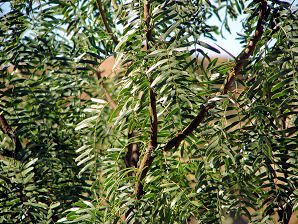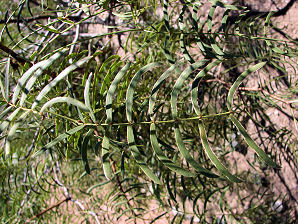Xeriscape Landscaping Plants For The Arizona Desert Environment.
Pictures, Photos, Information, Descriptions,
Images, & Reviews.
Trees.
Texas Honey Mesquite Trees,
Prosopis glandulosa v. glandulosa.
We Are Proud Of Our SafeSurf Rating!
Click On Any Of The Following Links By Amazon.Com
For Books, & Videos About Wildflowers Of Arizona & The Southwest USA. No Obligation!
 |
| Texas Honey Mesquite, Prosopis glandulosa v. glandulosa. Photo Taken October 11, 2006. Boyce Thompson Arboretum. |
|---|
 |  |
| Texas Honey Mesquite. Prosopis glandulosa v. glandulosa. | Texas Honey Mesquite. Prosopis glandulosa v. glandulosa. |
|---|
Texas Honey Mesquite Tree.
We wish to thank Wikipedia, the free encyclopedia for some of the information on this page. We share images and information with Wikipedia. Texas Honey Mesquite is a spiny deciduous tree that grows at a moderate rate to 20 or 50 feet. It has a spread to about 30 feet. It has bright green shiny leaves, its fine textured, branches often droop near the tips. In spring, when drooping tassels of creamy white flowers appear, followed by seed pods 3 to 9 inches in length. The Texas Honey Mesquite attracts a variety of desert wild life. Since it is a dense multi-branched shrub or small tree, the underbrush provides refuge for small desert mammals. Our desert rabbits will chew up the seed pods that fall to the ground by the end of summer, and the birds seek out the seeds. The edible pods taste similar to carob pods. Texas Honey Mesquite is on the Texas list of invasive species.
Quick Notes:
Height: Normally, about 20 feet. Can reach 30 feet. Same spread.
Trunk: An attractive gray shaggy - rough trunk.
Twigs: The twigs are jointy, branches gnarled and twisted.
Flowers: Pale green - yellow, 2 to 3 inches long, appearing in late spring and early summer. Inflorescences, axillary spikes. Racemes spiciform about 2 � 5 1/2 cm long, multiflorous; with the petals 1/32 � 1/16 inch long; ovary stipilate, villous.
Blooming Time: April to June.
Seed Pod: Brown pods; 3 - 9 inches long 1/2 inch wide.
Leaves: The leaves glabrous, uni- or bijugate; petiole (with rachis when extant) 3/4 � 6 inches long; pinnae 2 1/4 � 6 1/2 inches long; leaflets 6 to 17 pairs, about 1/4 - 3/4 inch distant on the rachis, either linear or oblong, obtuse, glabrous, subcoriaceous, prominently veined below,
with the costa often of lighter color, 3/4 � 2 3/4 inches long by 1/32 1/4 inch wide, usually 5 to 15 times as long as broad.
Found: The USDA claims it is native to the USA (CO, KS, LA, NM, OK, TX), USA+ (VI). Also native to the Sierra Madre Occidental of Eastern Sonora, Mexico. Also native to Chihuahua, Coahuila, Durango, Nuevo Leon, Sonora, Tamaulipas, & Zacatecas in Mexico.
Elevation: 0 to 5,200 feet.
Hardiness:
Soil pH requirements:
Sun Exposure:
Habitat: Rocky hillsides, alluvial plains, canyon slopes, and hillsides. Xeriscape ornamental in lower elevations or Arizona.
Miscellaneous: Photos Taken At October 11, 2006. Boyce Thompson Arboretum, near Superior, Arizona.
|



We Are Proud Of Our SafeSurf Rating!
Click On Any Of The Following Links By Amazon.Com
For Books, & Videos About Xerioscape Plants Of Arizona & The Southwest USA. No Obligation!
Back To Arizona Xeriscape Landscaping Main Page.
Back To Xeriscape Trees Page Five.
Back To Arizona Wild Flowers Home Page
Back To DeLange Home Page
© 1966 - Present, Audrey, Eve, & George DeLange
| © 1966 - Present, Audrey, Eve, & George DeLange |
